David Petersen's Blog, page 63
November 12, 2013
Skyward Cover Process
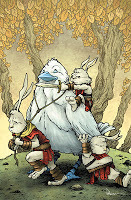 Jeremy Dale asked me to do a variant cover for his fantasy comic Skyward. It's an all-ages adventure story with a boy and his dog as the main protagonists. In this blogpost I'll discuss the process and steps of making the cover. The final color art can be seen to the left, but read on for more info.
Jeremy Dale asked me to do a variant cover for his fantasy comic Skyward. It's an all-ages adventure story with a boy and his dog as the main protagonists. In this blogpost I'll discuss the process and steps of making the cover. The final color art can be seen to the left, but read on for more info.My first step was to figure out what characters to feature. Jeremy and Kelly gave me to restrictions of the cover's subject, so I was open to do whatever I felt would be most interesting to me. Since I know I'm better at animal characters (and better known for them as well) rather than humans, I opted for the large bird character and three of the Rabites
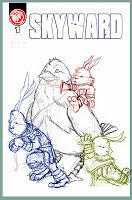 I sketched each of the Rabites separately as well as the bird in my sketchbook. Kelly had told me the Rabites would not be very likely to ever ride the bird, so I though it would be fun for the bird to remain planted while the three Rabites tried encouraging him to go. I scanned the sketches and assembled them in Photoshop. This allowed me to adjust scale, rotate figures (or just heads or arms) and get the positioning just right with the character's relation to one another as well as the borders of the cover. I also dropped in the logo to make sure I wasn't drawing anything important up there that may be covered up. The figures were each tinted to help me with the next step.
I sketched each of the Rabites separately as well as the bird in my sketchbook. Kelly had told me the Rabites would not be very likely to ever ride the bird, so I though it would be fun for the bird to remain planted while the three Rabites tried encouraging him to go. I scanned the sketches and assembled them in Photoshop. This allowed me to adjust scale, rotate figures (or just heads or arms) and get the positioning just right with the character's relation to one another as well as the borders of the cover. I also dropped in the logo to make sure I wasn't drawing anything important up there that may be covered up. The figures were each tinted to help me with the next step.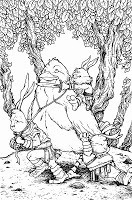 I printed out the digital layout above at full-size on regular printer paper (I had to print it in 2 parts and tape it together). I then used a low-tack masking tape to secure the printout to the back of a sheet of Strathmore 300 series bristol (my final working surface). On my lightbox I was able to see through the bristol and use the printout as a guide to ink on the bristol surface. Having each character tinted makes figuring out where one character ends and the next one starts all the easier. I inked this with a Copic Multiliner (nibs 0.7 & 0.35). I penciled the tree shapes and the ground's edge on the back of the cover (still on the lightbox) and then inked those in after the figures were completed.
I printed out the digital layout above at full-size on regular printer paper (I had to print it in 2 parts and tape it together). I then used a low-tack masking tape to secure the printout to the back of a sheet of Strathmore 300 series bristol (my final working surface). On my lightbox I was able to see through the bristol and use the printout as a guide to ink on the bristol surface. Having each character tinted makes figuring out where one character ends and the next one starts all the easier. I inked this with a Copic Multiliner (nibs 0.7 & 0.35). I penciled the tree shapes and the ground's edge on the back of the cover (still on the lightbox) and then inked those in after the figures were completed.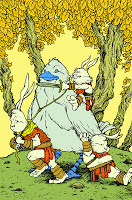 After the inks were done, I scanned those back into Photoshop and started the coloring process. The longest and most tedious part of coloring anything digitally is establishing flats. Because you are painting in flat colors, this step is called flatting. The color choices aren't as important as staying within the lines. In fact, you can use any colors at this stage, just so long as you are setting up that the Rabite fur is one color, and their tunics are another, and their arm & leg wraps yet another. I tend to not use my final colors while flatting because it helps me check if something isn't supposed to be as well as gets me less focused on selecting the right overall palette off the top rather than the work at hand of getting all the areas/color types isolated
After the inks were done, I scanned those back into Photoshop and started the coloring process. The longest and most tedious part of coloring anything digitally is establishing flats. Because you are painting in flat colors, this step is called flatting. The color choices aren't as important as staying within the lines. In fact, you can use any colors at this stage, just so long as you are setting up that the Rabite fur is one color, and their tunics are another, and their arm & leg wraps yet another. I tend to not use my final colors while flatting because it helps me check if something isn't supposed to be as well as gets me less focused on selecting the right overall palette off the top rather than the work at hand of getting all the areas/color types isolated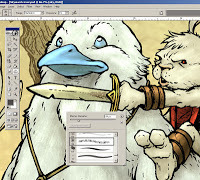 I render the flat colors (after I adjust them closer to what is my final idea of the color scheme) using the dodge & burn tools. These tools lighten and darken the base colors. In addition to using a brush with a texture so the work doesn't appear so digital, there are other controls for these tools like the range & exposure. Exposure controls how much lightening and darkening is one at once, but the range does a bit more than it would let on in title alone. The range can be set to 'highlights' 'midtones' or 'shadows' and while that controls which range of color tones will be most affected by the tool, it also sets how the color lightens or darkens ex:.if it saturates or desaturates on it's way to becoming lighter or darker.
I render the flat colors (after I adjust them closer to what is my final idea of the color scheme) using the dodge & burn tools. These tools lighten and darken the base colors. In addition to using a brush with a texture so the work doesn't appear so digital, there are other controls for these tools like the range & exposure. Exposure controls how much lightening and darkening is one at once, but the range does a bit more than it would let on in title alone. The range can be set to 'highlights' 'midtones' or 'shadows' and while that controls which range of color tones will be most affected by the tool, it also sets how the color lightens or darkens ex:.if it saturates or desaturates on it's way to becoming lighter or darker.Here again is the final cover art. The Dale's tell me it will be appearing on a future issue, and to keep up with them via Jeremy's site or his Twitter.
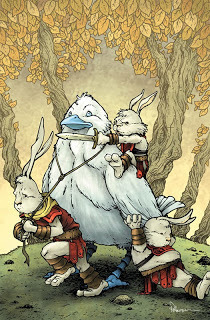
2014 Appearances:MSU Comics Forum: February 22Emerald City Comic Con: March 28-30C2E2: April 25-27Motor City Comic Con: May 16-18Comicpalooza: May 23-25Phoenix Comic Con: June 5-8Heroes Con: June 20-22San Diego Comic Con: July 23-27Boston Comic Con: August 8-10Baltimore Comic Con: Sept. 5-7NY Comic Con: Oct. 9-12
Published on November 12, 2013 06:00
November 5, 2013
Locke & Key Haed Games limited ed. originals
Locke & Key is a comic I was late to the game with but have been trumpeting as one of my favorite books ever since I discovered it. The folks over at IDW asked me to do artwork for their special limited editions of Head Games (the 2nd collection in the series). I was given 3 blank cover plates and 10 empty-head Bodies to fill with my take on imagery from the series (and not just limited to Head Games). An original (along with originals by Jim Mafood, Langdon Foss, Alan Robinson, & Tonya Harris) will be inserted in each book (Bodie Heads in the "Black Label books, Covers in the Black Label ones).
Below these final art images are sketches and in-progress shots as I worked on the project...
Black Label:
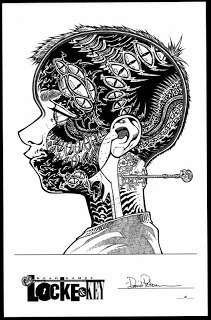 Beyond the Black Door
Beyond the Black Door
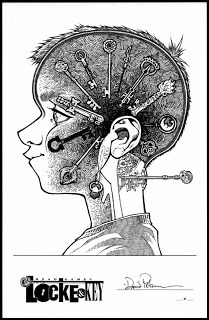 Keys
Keys
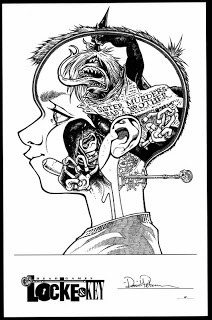 Tears & Fears
Tears & Fears
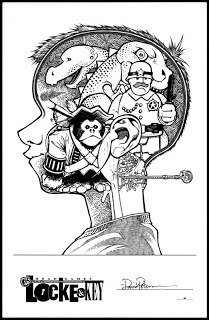 Toys
Toys
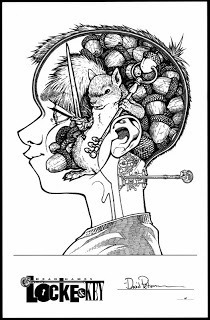 Undertree Key & Squirrel
Undertree Key & Squirrel
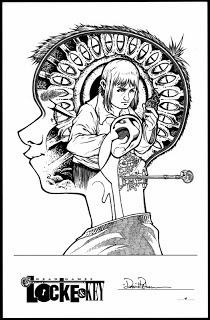 Benjamin Locke
Benjamin Locke
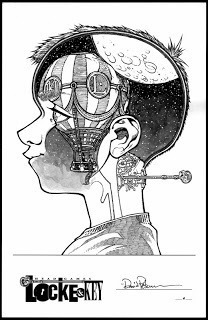 Open the Moon
Open the Moon
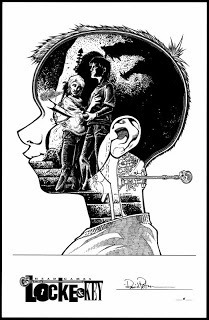 Dodge & Ellie
Dodge & Ellie
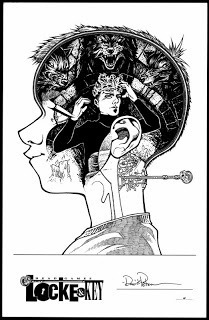 The Crown of Black Currants
The Crown of Black Currants
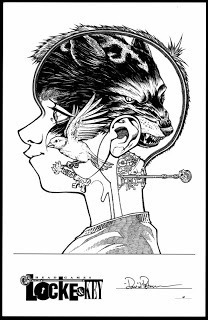 Animal Key
Animal Key
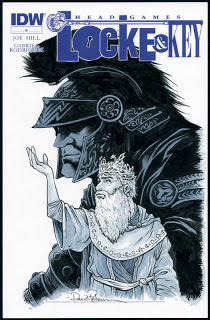 The Tempest
The Tempest
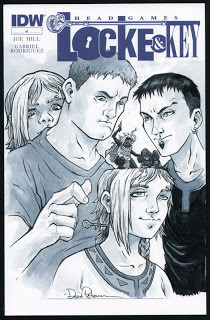 Open Mind
Open Mind
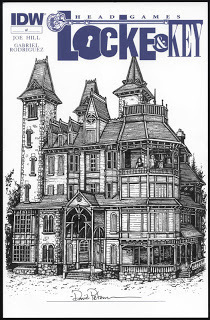 Keyhouse
Keyhouse
Process:
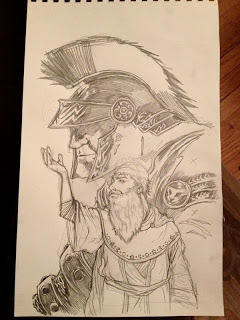
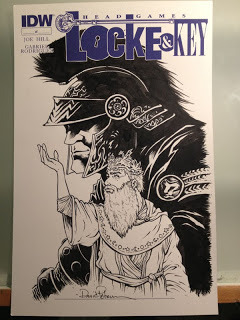
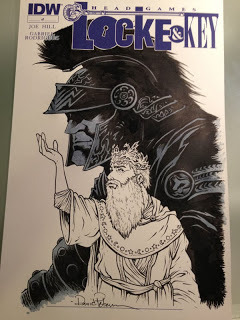
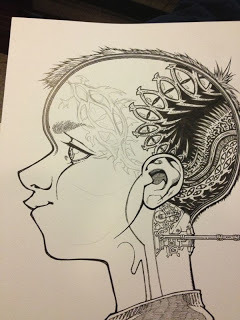
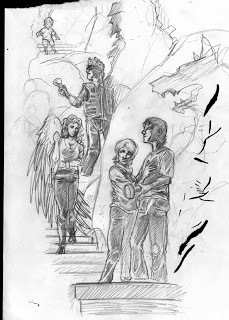

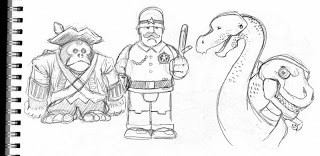
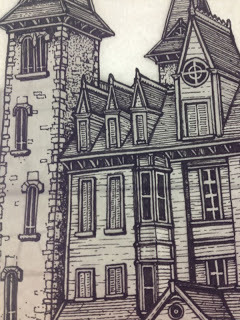
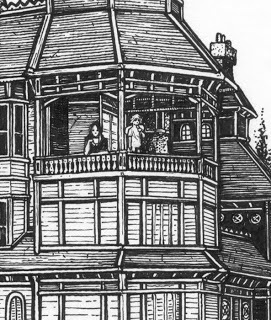
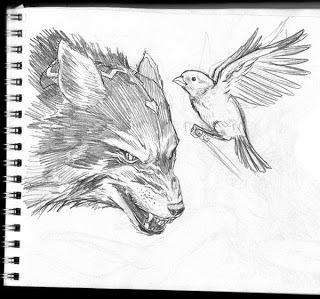

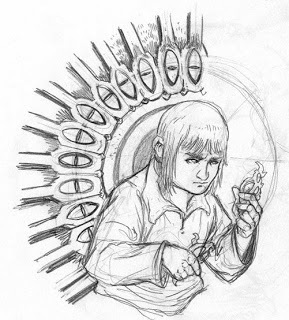
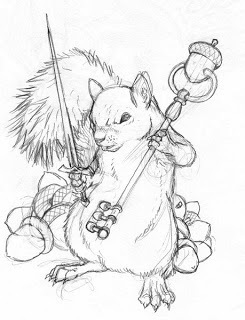

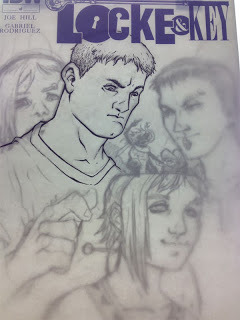
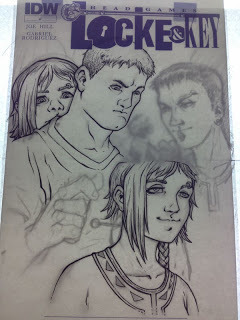
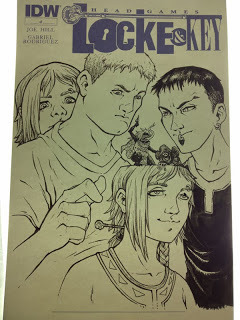
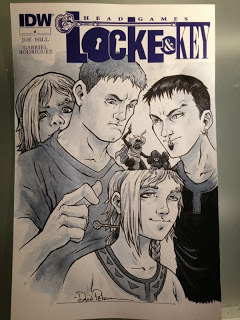
It was a pleasure and honor to get to do these, and I hope I get to play in and around Keyhouse again someday.
Upcoming Appearances:North Carolina Comic Con: November 9-10
Below these final art images are sketches and in-progress shots as I worked on the project...
Black Label:
 Beyond the Black Door
Beyond the Black Door Keys
Keys Tears & Fears
Tears & Fears Toys
Toys Undertree Key & Squirrel
Undertree Key & Squirrel Benjamin Locke
Benjamin Locke Open the Moon
Open the Moon Dodge & Ellie
Dodge & Ellie The Crown of Black Currants
The Crown of Black Currants Animal Key
Animal Key The Tempest
The Tempest Open Mind
Open Mind Keyhouse
KeyhouseProcess:


















It was a pleasure and honor to get to do these, and I hope I get to play in and around Keyhouse again someday.
Upcoming Appearances:North Carolina Comic Con: November 9-10
Published on November 05, 2013 06:00
October 29, 2013
Torchbearer RPG Chapter Illo
Luke Crane, who designed and wrote the Mouse Guard RPG wrote a new RPG called Torchbearer described by Luke as "Dungeon crawl roleplaying game and love letter to Basic D&D". He asked me to contribute a spot illustration for him for the chapter called "Winter". Here is the process for creating that piece for him.
 The rough started with the description "Exterior of a walled town. Creatures of all sorts lurk in the tree line, leering. A lone wanderer, bundled against the cold, trudges through the snowy waste, casting an ever weakening spell to protect him. The traveler could be Varg, Taika or Ulrik". For the monsters I decided to go with a group of Owlbears. I sketched the owlbears seprately, scanned them and composited them with a reference photo of myself and a stock symbol given to me by Luke as part of Varg's model sheet.
The rough started with the description "Exterior of a walled town. Creatures of all sorts lurk in the tree line, leering. A lone wanderer, bundled against the cold, trudges through the snowy waste, casting an ever weakening spell to protect him. The traveler could be Varg, Taika or Ulrik". For the monsters I decided to go with a group of Owlbears. I sketched the owlbears seprately, scanned them and composited them with a reference photo of myself and a stock symbol given to me by Luke as part of Varg's model sheet.
 Once I had a digital composite mocked up, I printed it out at 5" x 16". I taped that printout to the back of a sheet of Strathmore 300 series Bristol. On the lightbox I was able to see the printout as a guide as I inked.
Once I had a digital composite mocked up, I printed it out at 5" x 16". I taped that printout to the back of a sheet of Strathmore 300 series Bristol. On the lightbox I was able to see the printout as a guide as I inked.
 Lastly I scanned the inked artwork and digitally "colored" the piece (all in greyscale for the book's printing specs). To add more depth & effects, I used colorholds on the linework for the snow, castle, and magic spell.
Lastly I scanned the inked artwork and digitally "colored" the piece (all in greyscale for the book's printing specs). To add more depth & effects, I used colorholds on the linework for the snow, castle, and magic spell.
Torchbearer was Kickstarted as a project, but Luke will be offering copies for sale on his Burning Wheel Webstore starting Thursday: http://www.burningwheel.com/store/index.php/torchbearer.html
Upcoming Appearances:North Carolina Comic Con: November 9-10
 The rough started with the description "Exterior of a walled town. Creatures of all sorts lurk in the tree line, leering. A lone wanderer, bundled against the cold, trudges through the snowy waste, casting an ever weakening spell to protect him. The traveler could be Varg, Taika or Ulrik". For the monsters I decided to go with a group of Owlbears. I sketched the owlbears seprately, scanned them and composited them with a reference photo of myself and a stock symbol given to me by Luke as part of Varg's model sheet.
The rough started with the description "Exterior of a walled town. Creatures of all sorts lurk in the tree line, leering. A lone wanderer, bundled against the cold, trudges through the snowy waste, casting an ever weakening spell to protect him. The traveler could be Varg, Taika or Ulrik". For the monsters I decided to go with a group of Owlbears. I sketched the owlbears seprately, scanned them and composited them with a reference photo of myself and a stock symbol given to me by Luke as part of Varg's model sheet. Once I had a digital composite mocked up, I printed it out at 5" x 16". I taped that printout to the back of a sheet of Strathmore 300 series Bristol. On the lightbox I was able to see the printout as a guide as I inked.
Once I had a digital composite mocked up, I printed it out at 5" x 16". I taped that printout to the back of a sheet of Strathmore 300 series Bristol. On the lightbox I was able to see the printout as a guide as I inked. Lastly I scanned the inked artwork and digitally "colored" the piece (all in greyscale for the book's printing specs). To add more depth & effects, I used colorholds on the linework for the snow, castle, and magic spell.
Lastly I scanned the inked artwork and digitally "colored" the piece (all in greyscale for the book's printing specs). To add more depth & effects, I used colorholds on the linework for the snow, castle, and magic spell.Torchbearer was Kickstarted as a project, but Luke will be offering copies for sale on his Burning Wheel Webstore starting Thursday: http://www.burningwheel.com/store/index.php/torchbearer.html
Upcoming Appearances:North Carolina Comic Con: November 9-10
Published on October 29, 2013 06:00
October 22, 2013
Spotlight on Legends of the Guard contributor Bill Willingham:
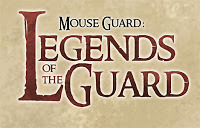 David Petersen: Bill, Thank you so much for doing the story and also for doing this interview.
David Petersen: Bill, Thank you so much for doing the story and also for doing this interview.Bill Willingham: You’re welcome. I’m happy to do the interview. I was absolutely tickled to be able to do the story.
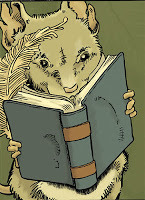 David: I’ve been touting that this Legends story is your return to drawing comics. What (and when) was the last comic you drew before this Legends of the Guard story?
David: I’ve been touting that this Legends story is your return to drawing comics. What (and when) was the last comic you drew before this Legends of the Guard story?Bill: I think I did a small two-page story for one of the Hero Initiative fundraising books a few years back. Before that, it was the two issues I did of my own DC series Shadowpact, when I foolishly thought I’d have time to both write and draw the series, without surrendering any of my other work – like Fables, for instance.
David: Why had you taken a break from the art side of storytelling?
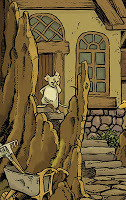 Bill: More of a breakdown than a break. No, wait. That’s too glib and also makes it look like I had a breakdown. Scratch that. I only meant to imply that something in the artist side of me broke at some point. As near as I can piece it together, the pathology went something like this: 1) I started as an artist only. 2) Strong opinions about the overall quality of the scripts I was given, along with a recognition of how much effort goes into producing page after page of art, led me, pretty quickly in the game, to start writing my own stories, under the notion that I can write as well as some and would have the advantage of producing scripts the artist part of me will want to draw. 3) Gradually I wrote more and drew less. 4) Eventually I settled into the realization that I could tell more stories as a writer than as an artist, or by doing both. I never entirely gave up the art side. I’m about to publish a book of what I've been drawing all along, mostly of false-starts on longer works. I suspect I could still draw a monthly book, as long as that is all I do. However, one drawn book a month isn't enough for me. That would preclude too many other story projects.
Bill: More of a breakdown than a break. No, wait. That’s too glib and also makes it look like I had a breakdown. Scratch that. I only meant to imply that something in the artist side of me broke at some point. As near as I can piece it together, the pathology went something like this: 1) I started as an artist only. 2) Strong opinions about the overall quality of the scripts I was given, along with a recognition of how much effort goes into producing page after page of art, led me, pretty quickly in the game, to start writing my own stories, under the notion that I can write as well as some and would have the advantage of producing scripts the artist part of me will want to draw. 3) Gradually I wrote more and drew less. 4) Eventually I settled into the realization that I could tell more stories as a writer than as an artist, or by doing both. I never entirely gave up the art side. I’m about to publish a book of what I've been drawing all along, mostly of false-starts on longer works. I suspect I could still draw a monthly book, as long as that is all I do. However, one drawn book a month isn't enough for me. That would preclude too many other story projects.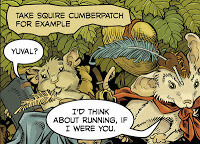 David: Last spring, you brought a group of comic storytellers together (including myself and the Mice Templar folks) for Fabletown and Beyond under the banner of us all being "Mythic Fiction". Can you explain how you see that category of story and why it’s important?
David: Last spring, you brought a group of comic storytellers together (including myself and the Mice Templar folks) for Fabletown and Beyond under the banner of us all being "Mythic Fiction". Can you explain how you see that category of story and why it’s important?Bill: Mythic Fiction is our first heroic storytelling genre. It’s Beowulf and Gilgamesh and The Iliad, and so much more. Superheroes, if anything, are a subset of that genre – one that is currently having a bit of trouble keeping in touch with the wondrous aspect of the form, but I’m confident they’ll find their way again. I can’t say for certain why Mythic Fiction is important in the grand scheme, but it’s vital for me, because most of what I want to say lies within its magical boundaries.
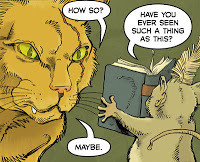 David: For your Legends of the Guard story you have a mouse outwitting a cat to save his own life. Where did the seed of this story come from?
David: For your Legends of the Guard story you have a mouse outwitting a cat to save his own life. Where did the seed of this story come from?Bill: In our current pop fiction, most professional warriors are portrayed as dimwitted thugs, whereas the opposite is true. The best soldiers have always had to be smart. I liked the idea of an old retired campaigner who no longer had his strength and martial skill, but still had his wits about him.
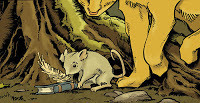 David: When you start a story that you are going to both write and draw, do you start with any visuals? or does the writer cap get donned first for an outline or script?
David: When you start a story that you are going to both write and draw, do you start with any visuals? or does the writer cap get donned first for an outline or script?Bill: Both. Depends on the story. In this case, I wrote it first and drew it following the script. In other cases it’s a more organic thing, creating art and story as I go.
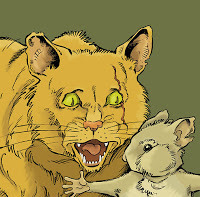 David: From veteran writer/artist Sergio Aragonés to me when I was starting out on a writer/artist path: Never allow the artist side of you to bully the writer side of you into writing something easy to draw. And never let the writer in you bully the artist to draw something that doesn’t work visually. Do you ever wrestle with the two roles when writing and drawing the same project? Or do you work in harmony with yourself?
David: From veteran writer/artist Sergio Aragonés to me when I was starting out on a writer/artist path: Never allow the artist side of you to bully the writer side of you into writing something easy to draw. And never let the writer in you bully the artist to draw something that doesn’t work visually. Do you ever wrestle with the two roles when writing and drawing the same project? Or do you work in harmony with yourself?Bill: I constantly wrestle with the two halves of the Jekyll and Hide artist/writer relationship. And I think that’s the only way to do it. If both sides are in harmony, I would immediately think that both sides are taking it easy.
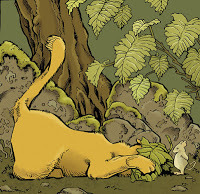 David: For the artwork how do you start? With thumbnails or straight to the final paper surface?
David: For the artwork how do you start? With thumbnails or straight to the final paper surface?Bill: Straight to the final page. Any joy I find in my own art comes from the spontaneity of the drawing. Start with thumbnails or layouts, or what-have-you, and that spontaneity gets leached out along the way. If I have the script and am doing my own lettering, I also letter each panel first, before a single line is placed on the page, to establish the real space I have in which to draw.
David: What are your preferred tools for drawing and inking?
 Bill: I use a standard lead holder with a # 2 lead (although that can change, depending on the surface of the paper). Then I ink with Black Magic ink applied with a Windsor Newton # 2 brush. Can’t ink with a pen to save my life.
Bill: I use a standard lead holder with a # 2 lead (although that can change, depending on the surface of the paper). Then I ink with Black Magic ink applied with a Windsor Newton # 2 brush. Can’t ink with a pen to save my life.David: What artists influenced your work as you developed as both an artist and writer? Do you still look to certain artists for visual inspiration today? or certain writers for inspiration?
Bill: All of them. Anyone who caught my eye. The greatest influences art-wise today can be found in the classic age of magazine illustration (now sadly passed). Writers are the same. Anyone and everyone who writes well inspires me.
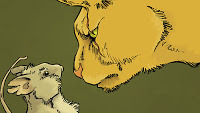 David: Bill, Thank you again for the story. Where can people find out more about you and your work?
David: Bill, Thank you again for the story. Where can people find out more about you and your work?Bill: You can find my main project, Fables, at any comic shop. We've been doing it for eleven years now and about 140 issues. By the time this is posted, Telltale Games will have also released the first of its many video games based upon Fables, called The Wolf Among Us. We keep the Fables books in print, in about 20 collections, and most shops are good at keeping those in stock. To find out more about me, I sort of have a website that I sort of keep up to date. I think it’s at BillWillingham.com. I also tweet via @BillWillingham.
Bill's Story The Vetran will appear in Legends of the Guardvolume 2 # 4 along with stories by Jackson Sze & Justin Gerard
Upcoming Appearances:North Carolina Comic Con: November 9-10
Published on October 22, 2013 06:00
October 15, 2013
Spotlight on Legends of the Guard contributor Justin Gerard:

As a note to the readers, Justin’s story is a little different from the others. The story takes the form of a song with musical notation. Each page is a verse and has a 1/3 page illustration of the verse by Justin. Because I don’t want to spoil much of the story, this interview will focus more on Justin and his work and process than the Legends story itself.
David Petersen: Justin, Thanks for doing the story on short notice! And I appreciate you doing the interview too. I was very glad to get you on-board for this project. When I’d asked you before the song framework was an option, you’d been worried about doing sequential storytelling. Do you have the desire to tell stories longer than a few illustrations allow? either with comics or prose? When I look at your sketchbooks I always feel like there is a bigger story you are itching to tell.
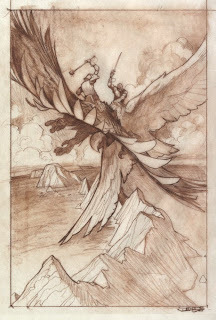 Justin Gerard Oh definitely. Most of them start out as just little doodles without much meaning or context. Just a character that seems interesting. But then you kind of can't help but start designing a world around them that seems appropriate to them. And once you've done that it's hard not to start populating it and exploring it. And then the story part sort of develop naturally whether you mean for it to or not.
Justin Gerard Oh definitely. Most of them start out as just little doodles without much meaning or context. Just a character that seems interesting. But then you kind of can't help but start designing a world around them that seems appropriate to them. And once you've done that it's hard not to start populating it and exploring it. And then the story part sort of develop naturally whether you mean for it to or not. So most of these worlds end up with stories that I definitely wish I could cobble into some kind of larger and more cohesive whole. Sadly, I am not the most gifted writer, and when I try to mesh the writing with the images, it doesn't always work as well as I'd like.
But I do have some plans in the works for the next sketchbook that will involve a lot more writing with the images... (Can't really say more at the moment, but check back on my blog in August!)
David: Talk about your background in art. Were you one of those kids that was drawing before you were walking? Did you have family support to continue in art? What was your pre-college art education like?
Justin: Haha, yes I probably was one of those kids who was drawing before he was walking. My memory is terrible, so I can't say that for sure, but it seems like it.
My mother claims that she drew pictures in my peanut butter sandwiches and then takes all the credit for my stuff. (Which probably answers the second question) My parents were definitely very supportive and I owe them a great deal for everything.
 I went to Bob Jones University for art. My college art experience wasn't much to speak about. Most of what I gained from college was probably taste, rather than technical ability. Bob Jones has a really incredible collection of religious art, in particular a gallery with quite a few enormous Benjamin West paintings in them.
I went to Bob Jones University for art. My college art experience wasn't much to speak about. Most of what I gained from college was probably taste, rather than technical ability. Bob Jones has a really incredible collection of religious art, in particular a gallery with quite a few enormous Benjamin West paintings in them. I stole a step by step guide from the library while I was there. It was the one with the Peter DeSeve tutorial in it. (The one with the pirates.) I studied it voraciously and never returned it. To this day it has probably had more impact on how I work than anything else I ever came across.
However, probably the best education I got, I got at the universities book press, where I worked while I was in college. It was awesome experience and did tons to prepare me for the professional world and freelance illustration. I am really thankful for the opportunity to work there during college.
David: You now teach art and illustration through a few venues including the Lamp Post Guild. Was there something from your education you felt really needed to be passed on or a case of you wanting to help new students fill in all the gaps your formal training lacked? What is the best piece of illustration advice you have even been given or could give?
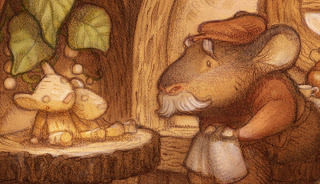 Justin: Hmmmm… Actually, what it is I think, is that I want to teach at a school someday; But not yet.
Justin: Hmmmm… Actually, what it is I think, is that I want to teach at a school someday; But not yet. For now I would just like to do smaller presentations, and classes and demos where I can. Right now I still have all these ideas and things I want to try. Clients I want to work for, projects I want to do and shows I want to have. I would like to gain a bit more experience in the commercial art world before feeling like I would be ready to teach full-time. That way, when I go to teach, I will have the benefit of actual market experience, and won't just be theorizing about the way I think the market ought to be.
As far as advice goes, I would say, only do this if you really love just sitting alone and drawing. And if you do find that you love that, then just do it a lot. Just draw a ton, and draw the things you love.
David: By looking at your blog, it’s clear you do a great deal of process work before the final image including character studies, layouts, color composites, and preliminary paintings. How do you keep from going too far in an image’s development so you don’t feel it’s overworked or that you've overstayed your creative welcome in that image...all while still doing the right amount of preparation?
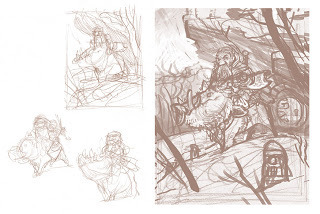 Justin: Oftentimes this is taken care of for me because deadlines and client needs only permit me to do a certain amount of preliminary work. It does get a little more tricky when it is purely my own work and I sometimes do overwork the preliminary stage. It is definitely a delicate balance. In general though it is just how much patience I can muster up. I think drawing and redrawing an image almost ALWAYS makes it better. You may lower the overall amount of work you put
Justin: Oftentimes this is taken care of for me because deadlines and client needs only permit me to do a certain amount of preliminary work. It does get a little more tricky when it is purely my own work and I sometimes do overwork the preliminary stage. It is definitely a delicate balance. In general though it is just how much patience I can muster up. I think drawing and redrawing an image almost ALWAYS makes it better. You may lower the overall amount of work you put out, but you will definitely raise the overall quality of your work.
David: My readers enjoy hearing about tools of the trade, please share what you like to draw with, paper surfaces, color methods, etc.
Justin: I tend to switch things up a lot when I work. It is rarely the same method twice.
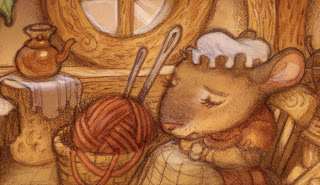 However, my approach is generally the same. Basically, I do a lot of drawing and then do an underpainting and intiial colors traditionally, and then I scan this in and finish everything digitally in Photoshop. (Adding darker darks and more intense colors.)
However, my approach is generally the same. Basically, I do a lot of drawing and then do an underpainting and intiial colors traditionally, and then I scan this in and finish everything digitally in Photoshop. (Adding darker darks and more intense colors.) I will work in pencil or oil or acrylic or watercolor depending on what I am wanting to do with the piece.
But perhaps the method I end up going back to the most is colored pencils and watercolor on Strathmore 500 series vellum bristol which I then work digitally over top of.
David: Who would you cite as creative influences?
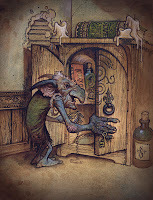 Justin: The list is enormous and it would be impossible to mention all of them. DeSeve is a great one obviously, Gustafson, Bonner and Meseldzija are perhaps some of the most influential for me as far as contemporaries go. Rackham, Rembrandt, Leighton, Friedrich and Dore for the classics. But really the list is enormous, I am always interested in discovering new talent and stumbling on classics I never knew of. Last week I stumbled on a French Academic painter named Vibert Jehan Georges whose oil paintings are just amazing, and everyone should check out his work. It's just fantastic.
Justin: The list is enormous and it would be impossible to mention all of them. DeSeve is a great one obviously, Gustafson, Bonner and Meseldzija are perhaps some of the most influential for me as far as contemporaries go. Rackham, Rembrandt, Leighton, Friedrich and Dore for the classics. But really the list is enormous, I am always interested in discovering new talent and stumbling on classics I never knew of. Last week I stumbled on a French Academic painter named Vibert Jehan Georges whose oil paintings are just amazing, and everyone should check out his work. It's just fantastic. David: What projects are coming up next that folks should look out for?
Justin: I have got the aforementioned sketchbook that I hinted at earlier, as well as an illustrated book in the works. They are both still in development, but I am hoping to announce the details of it in August this year. Likely, there will be goblins, dwarves, trolls and dragons with bad table manners...
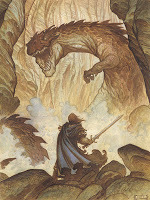 David: I'm really looking forward to that project! Justin, thanks again for doing the story and interview. Where can people find out more about you and your work?
David: I'm really looking forward to that project! Justin, thanks again for doing the story and interview. Where can people find out more about you and your work?Justin: I am terrible with social media. I promise to reform and get my act together later this year. For now, the best place is my blog: www.quickhidehere.blogspot.com
Justin's Story The Timber Mice (with music written by Cliff Monear)
will appear in Legends of the Guard volume 2 # 4
along with stories by Bill Willingham & Jackson Sze
Upcoming Appearances:North Carolina Comic Con: November 9-10
Published on October 15, 2013 06:00
October 8, 2013
Spotlight on Legends of the Guard contributor Jackson Sze:
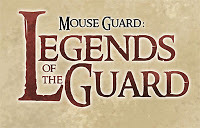 David Petersen: You are not normally a comic-guy, tell the readers about your work and background.
David Petersen: You are not normally a comic-guy, tell the readers about your work and background.Jackson Sze: Thanks for chatting with me, and also, thank you so much for allowing me to spend some time in the world of MouseGuard. I am truly grateful for the opportunity! I am a Concept Artist based in Los Angeles. Right now I’m working in movies, but I’ve been fortunate enough to work in other areas such as videogames, television, advertising… and now, a little bit of Comics! Environment Design is what I concentrated on in school, but lately I’ve been trying to do more storytelling with my illustrations. Working on MouseGuard has been a great way for me to explore visual storytelling.
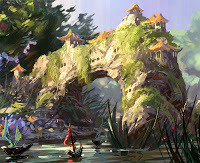
David: I am very pleased that Legends of the Guard is your comic debut! Had you wanted to do comics before? or did I just twist your arm enough?
Jackson: Comics has always seem an intimidating medium for me. I don’t have comic experience, and to be responsible for everything at once was a terrific challenge. Thanks to the support both you and Paul gave me, I think I managed to tell a coherent short story. Thanks for asking me to do it. I am so glad I did.
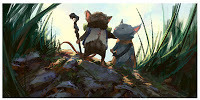 David: I really admire your paintings of settings and locations. So, while I try and stay as hands-off as possible with these Legends stories, I did encourage you to do a story based on the theme of visiting several locations. Tell the readers about the process you went through to shape that push of mine into a narrative and give us a tease of what it’s about.
David: I really admire your paintings of settings and locations. So, while I try and stay as hands-off as possible with these Legends stories, I did encourage you to do a story based on the theme of visiting several locations. Tell the readers about the process you went through to shape that push of mine into a narrative and give us a tease of what it’s about.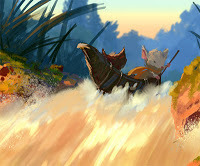 Jackson: Thanks for the suggestions! Environment design is what I am most comfortable with, so that is a great starting point for me to think about the story. In order to showcase the locations, we needed a tour guide of sorts to bring the readers along. Things will hopefully feel fresher if our characters are experiencing these areas for the first time as well. A cartographer mouse seems an ideal character to be our guide on this journey. With this short story, our characters will travel to foreign lands beyond the known mouse territories. Hopefully there will be some character growth as well as actual journeying accomplished by the end.
Jackson: Thanks for the suggestions! Environment design is what I am most comfortable with, so that is a great starting point for me to think about the story. In order to showcase the locations, we needed a tour guide of sorts to bring the readers along. Things will hopefully feel fresher if our characters are experiencing these areas for the first time as well. A cartographer mouse seems an ideal character to be our guide on this journey. With this short story, our characters will travel to foreign lands beyond the known mouse territories. Hopefully there will be some character growth as well as actual journeying accomplished by the end. David: Since you normally are doing single images or a series of images meant to shape the viewers’ understanding of an environment’s atmosphere and design, did you find telling a story in pictures a great departure? or did it come naturally?
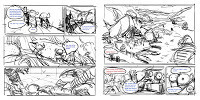 Jackson: I had to find a balance between character driven storytelling, and showcasing the locations. In the end I treated the comic like an animated film, imagining the shots I’d like to see, while working in the panel structure of comics.
Jackson: I had to find a balance between character driven storytelling, and showcasing the locations. In the end I treated the comic like an animated film, imagining the shots I’d like to see, while working in the panel structure of comics. David: What artists inspire you and your work?
 Jackson: Hayao Miyazaki’s Laputa is why I am an artist today. His movies inspired me greatly as a child. Otherwise, impressionist painters, California Impressionism and the many excellent contemporary digital painters continue to inspire my love of painting.
Jackson: Hayao Miyazaki’s Laputa is why I am an artist today. His movies inspired me greatly as a child. Otherwise, impressionist painters, California Impressionism and the many excellent contemporary digital painters continue to inspire my love of painting. David: How about telling readers the process of making your artwork. It’s all digital, but walk us through your process and tell us about your set-up.
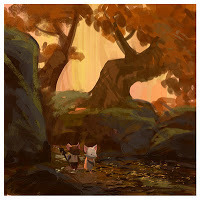 Jackson: My process is pretty typical, and yes this comic was done digitally. After writing the script, I’d imagine the shots I’d like to see and loosely lay them out on the page. These will be rough sketches. Often I’ll have to adjust what I had in mind to what is actually working on the page. Mostly I hope to communicate clearly what is happening in each shot, while maintaining some sense of continuity. A change in the camera’s perspective here and there helps add contrast to the visuals. The panels were often regarded as a series rather than a single image. What came before, what’s interesting after… that kind of thing. After the lay in, I’d do a color pass on the entire comic, adjust and refine till it’s done! Setup wise I have a dual monitor setup with a PC. I went back to using a Wacom tablet after a few years of using the Cintiq… it’s all about screen real estate!
Jackson: My process is pretty typical, and yes this comic was done digitally. After writing the script, I’d imagine the shots I’d like to see and loosely lay them out on the page. These will be rough sketches. Often I’ll have to adjust what I had in mind to what is actually working on the page. Mostly I hope to communicate clearly what is happening in each shot, while maintaining some sense of continuity. A change in the camera’s perspective here and there helps add contrast to the visuals. The panels were often regarded as a series rather than a single image. What came before, what’s interesting after… that kind of thing. After the lay in, I’d do a color pass on the entire comic, adjust and refine till it’s done! Setup wise I have a dual monitor setup with a PC. I went back to using a Wacom tablet after a few years of using the Cintiq… it’s all about screen real estate! David: Lighting & atmosphere is very strong in your work. How early in image making are you thinking about the color palette and it’s lighting? Do you have a clear image in your mind before you start painting? or does it develop through early sketching and blocking in shapes?
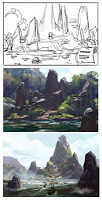 Jackson: I knew I wanted a color scheme that makes sense throughout the story. So as I do the first color pass, I’m thinking about the mood I want to achieve, time of day, weather conditions, seasons, things like that. The rough pass acts as a mini color script and I adjust for continuity and variety. The plan was to start with an overcast morning, vary the colors of their journey, and end with a sunset.
Jackson: I knew I wanted a color scheme that makes sense throughout the story. So as I do the first color pass, I’m thinking about the mood I want to achieve, time of day, weather conditions, seasons, things like that. The rough pass acts as a mini color script and I adjust for continuity and variety. The plan was to start with an overcast morning, vary the colors of their journey, and end with a sunset. David: Thanks Jackson. Where can readers find out more about you and your work?
Jackson: Thanks again David, for letting me do this. It has been educational and rewarding. My website is www.jacksonsze.com and my blog is at www.jacksonsze.blogspot.com
Jackson's Story Back and Forth will appear in Legends of the Guard
volume 2 # 4 along with stories by Bill Willingham & Justin Gerard
Upcoming Appearances:New York Comic Con: October 10-13North Carolina Comic Con: November 9-10
Published on October 08, 2013 06:00
October 1, 2013
Skelton Crew Replica Weapons update
 Israel Skelton ovSkelton Crew Studios released a mouse-scale replica the Black Axe last year...but that piece was only the beginning of a larger line or replica products for the Mouse Guard fans...In this post, I wanted to share a bit of what Israel and I have planned for the future of this line and for your mouse-sized armory.
Israel Skelton ovSkelton Crew Studios released a mouse-scale replica the Black Axe last year...but that piece was only the beginning of a larger line or replica products for the Mouse Guard fans...In this post, I wanted to share a bit of what Israel and I have planned for the future of this line and for your mouse-sized armory.Rand's Shield:
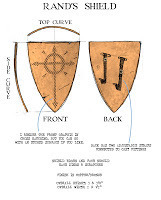 Two weeks ago saw the release of Rand's shield. I first drew a piece of control art with measurements for Israel. When I draw this artwork, I have to look at all of the times I've drawn that piece in the Mouse Guard books and come up with an amalgamation of it ignoring inconsistencies and making an idealized version of the weapon or, in this case, armor. I try and give Israel different views and suggestions of how I see details working for the replica.
Two weeks ago saw the release of Rand's shield. I first drew a piece of control art with measurements for Israel. When I draw this artwork, I have to look at all of the times I've drawn that piece in the Mouse Guard books and come up with an amalgamation of it ignoring inconsistencies and making an idealized version of the weapon or, in this case, armor. I try and give Israel different views and suggestions of how I see details working for the replica.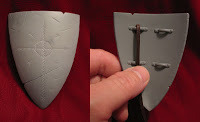 Israel then makes a prototype. For Rand's Shield, we discussed what to do about the back where the straps would go. I suggested they could be cast metal that was painted, or they could be left off...as though they have rotted away. But Israel insisted that if they are supposed to be leather straps, he would make sure the replicas all had leather straps. This photo is one he sent me to show an example of the strap material against the prototype.
Israel then makes a prototype. For Rand's Shield, we discussed what to do about the back where the straps would go. I suggested they could be cast metal that was painted, or they could be left off...as though they have rotted away. But Israel insisted that if they are supposed to be leather straps, he would make sure the replicas all had leather straps. This photo is one he sent me to show an example of the strap material against the prototype.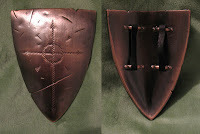 The final product is a pewter casting that has been plated and antiqued to look like the shield from the comic (or even better in my opinion). This photo shows a near final version of the shield, Israel had some finish tweaks he wanted to do before they went into production. And these are available through the Skelton Crew store currently.
The final product is a pewter casting that has been plated and antiqued to look like the shield from the comic (or even better in my opinion). This photo shows a near final version of the shield, Israel had some finish tweaks he wanted to do before they went into production. And these are available through the Skelton Crew store currently.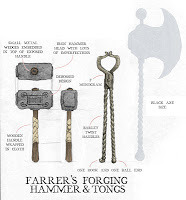 Farrer's Hammer & Tongs:
Farrer's Hammer & Tongs:The next scheduled item is actually a pair of items. The hammer and tongs of Farrer, the mouse who forged the mythic Black Axe. For the control art I included a scale reference to the Black Axe, something Israel appreciated and requested I do in all the new pieces. I talked Israel out of having each hammer's handle be made of real wood...however, the tongs will pivot and function as real tongs would.
Beyond these pieces, we don;t have a release schedule or order set, but these are most likely the pieces that will follow the hammer and tongs...
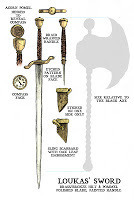 Loukas' Sword:
Loukas' Sword: The design of this sword started with a drawing Jeremy Bastian did for my 30th Birthday of a mouse wielding a sword like this one. I liked the drawing and sword so much, I told him I was stealing it. In the Mouse Guard comics it became Saxon's mentor Loukas' sword...which Saxon later inherits. Israel has informed me that while the hinge won't match mine, and there will be no working compass inside, the acorn-cap pommel will indeed open in the replica...even though it will be no bigger around than a pencil eraser.
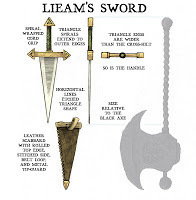 Lieam's Sword:
Lieam's Sword:That strange triangle sword I drew for Lieam has become an iconic weapon for the character (even though he only had it in issues #1 & half of #3 in Fall...) Because my drawings had changed so much between when I drew Fall 1152 and now (as well as the times I've drawn Lieam with this sword for spot illos and commissions) I had to really adjust the proportions and design of the sword into this version. Because the next volume of Mouse Guard will take place in 1149, Lieam will again have this sword...which will make the replica a welcome addition to my reference shelf.
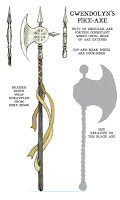 Gwendolyn's Pike-Axe:
Gwendolyn's Pike-Axe:Israel requested this one come sooner than later. I designed the weaspon for Gwendolyn as something of a cross between fuctional and cerimonial. I wanted it te be something she could 'knight' mice into the Guard with and keep enimies at a distance with. In taklking with Israel, I mentioned that I knew the braided cloth would be a pain for this replica so he could scrap them if he wanted...but not Israel. He said they will all have the braided cloth for certain when it comes time to make this replica.
Beyond these, Israel and I have a long list of things from the existing Mouse Guard books (including Legends of the Guard) and future Mouse Guard books. Here's a taste of what else we want to tackle:
-Kenzie's staff w/ lantern
-Sadie's daggers
-Celanawe's sword
-Delvin's Sheild
-Delvin's sword
-Bastian's bow~
-Leaf Hilt sword
-Sienna's mace
-Conrad's spear/hook
-Luthebon's sword (weasel scale)
-The tooth horns from the Legends cover
It's wonderful as a creator to entrust your world and designs to a skilled and talented craftsman like Israel Skelton. I hope you fans agree.
Upcoming Appearances:New York Comic Con: October 10-13North Carolina Comic Con: November 9-10
Published on October 01, 2013 06:00
September 24, 2013
Spotlight on Legends of the Guard contributor Eric Canete:
 David Petersen: Eric, Thanks for taking the time to do the story and for doing the interview. Let’s start the interview with your artistic beginnings. When did you first start thinking about art as a career? Were you a child who knew you wanted to draw for the rest of your life, or did a specific moment get you on your creative path?
David Petersen: Eric, Thanks for taking the time to do the story and for doing the interview. Let’s start the interview with your artistic beginnings. When did you first start thinking about art as a career? Were you a child who knew you wanted to draw for the rest of your life, or did a specific moment get you on your creative path?Eric Canete: Thanks for having me. Doing the story was probably the most notable highlight in my career in recent memory - it was such an honor and so much fun to do.
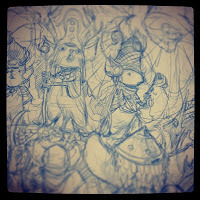 I was prompted in a career in art by an older cousin, Ferdinand, who drew really well when we were young. I was very jealous of his ability and recall him being able to draw anything in any style - from fashion illustrations to Star Wars; anything he saw, he could draw. So whenever he would doodle, I would always try it for myself - with less accomplished results. But that friendly competition really started me in the physical act of trying to get better at drawing. From there, it was just being influenced by all the cartoons and comics I was looking at and watching at the time.
I was prompted in a career in art by an older cousin, Ferdinand, who drew really well when we were young. I was very jealous of his ability and recall him being able to draw anything in any style - from fashion illustrations to Star Wars; anything he saw, he could draw. So whenever he would doodle, I would always try it for myself - with less accomplished results. But that friendly competition really started me in the physical act of trying to get better at drawing. From there, it was just being influenced by all the cartoons and comics I was looking at and watching at the time.David: While you've drawn comics in the past, your background and day jobs are in animation, storyboarding, and design. Obviously comics and storyboarding have similar qualities, but from someone who does both well, can you talk about what makes them very different from one another?
Eric: Like you said, there are a handful of crossover in both disciplines. It's sort of funny that, whenever I do comic book pages, I draw them almost as if I'm storyboarding. I know many of my peers are really involved with page lay outs and what helps best draw the eye from panel to panel - there's a whole science to it all. I used to really invest in learning those theories, but these days, I just draw my pages like I'm storyboarding.
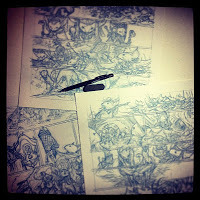 The biggest difference, when it comes to drawing comic book pages versus drawing storyboards for animation, is the sheer pencil mileage involved in doing an action adventure storyboard for the screen. Every beat has to be spelled out, every acting nuance has to be drawn. Whereas in comics, the artist can expect the audience to fill in between the lines as to what happened from one panel to another, animation can't do that - it's simply not good cinema. There are instances when you can 'jump time' and not show Point A to Point B, but for the most part, ALL action has to be spelled out. That takes a lot of drawing.
The biggest difference, when it comes to drawing comic book pages versus drawing storyboards for animation, is the sheer pencil mileage involved in doing an action adventure storyboard for the screen. Every beat has to be spelled out, every acting nuance has to be drawn. Whereas in comics, the artist can expect the audience to fill in between the lines as to what happened from one panel to another, animation can't do that - it's simply not good cinema. There are instances when you can 'jump time' and not show Point A to Point B, but for the most part, ALL action has to be spelled out. That takes a lot of drawing.David: While I like giving the freedom to Legends of the Guard contributors to come up with their own stories, you specifically asked me to give you some story direction and outlines. I provided you several story seeds including: a story about a mouse with a flaming sword, a mouse who carved puppet children for himself, trees that could talk to animals, and an old world mouse who first brought fire to his species...but you opted for the one I suggested as a re-telling of an Aesop fable with a war between mice and weasels. Was there any reason you chose that story over the others?
 Eric: It was such a HUGE deal for me to be involved in Legends of the Guard. I asked for your help in writing brief story ideas because I didn't want to miss the overall tone for the series. I'm a novice writer so I can't say I'm 100% comfortable doing things on my own yet, and it takes me so long to ideate on a story that in this particular case, I just really wanted to get the task of drawing without the worry of being too far off center with the story. I figured, if I went straight to the source for what's a good fit tonally, then it's that much easier and sooner that I can get to the task of drawing.
Eric: It was such a HUGE deal for me to be involved in Legends of the Guard. I asked for your help in writing brief story ideas because I didn't want to miss the overall tone for the series. I'm a novice writer so I can't say I'm 100% comfortable doing things on my own yet, and it takes me so long to ideate on a story that in this particular case, I just really wanted to get the task of drawing without the worry of being too far off center with the story. I figured, if I went straight to the source for what's a good fit tonally, then it's that much easier and sooner that I can get to the task of drawing.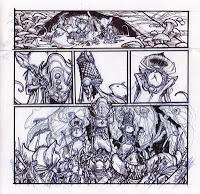 As far as choosing this particular story over the others - it was the challenge of it all. I had the opportunity to draw an epic battle between mice and weasels, and I got excited and jumped all over it. I figured an artist - even within the context of this series - doesn't get a chance to do that every day. Also, I really wanted to draw pages that was somewhat out of my comfort zone. Between all the synopses you had written, choosing this story really offered that opportunity.
As far as choosing this particular story over the others - it was the challenge of it all. I had the opportunity to draw an epic battle between mice and weasels, and I got excited and jumped all over it. I figured an artist - even within the context of this series - doesn't get a chance to do that every day. Also, I really wanted to draw pages that was somewhat out of my comfort zone. Between all the synopses you had written, choosing this story really offered that opportunity.David: In the development of your thumbnails, you asked if I could give you more space for a splash page...and it turned out, I was able to shift things around and offered you a two-page spread (the first in Legends of the Guard). This spread is incredible! And does exactly what a two page spread should, give the reader a sense of awe, grandeur, and scope. You are known for dynamic designs, but this must have been a killer series of pages to layout, draw and ink! Describe what it was like to work on them.
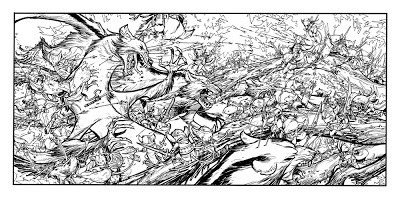
Eric: Wow! I didn't know you accommodated that double page lay out. I'm so grateful!
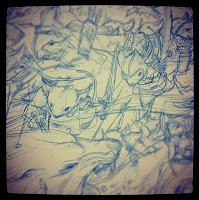 Your description of the hows and whys of doing any huge spread is exactly the motivation for my request in having it. I try to deeply immerse the reader into the feeling of the story I'm drawing. In this specific case, the story called for an epic battle of heroic warrior mice and evil deadly weasels. I was inspired by that and strove to give that scene as much weight as possible.
Your description of the hows and whys of doing any huge spread is exactly the motivation for my request in having it. I try to deeply immerse the reader into the feeling of the story I'm drawing. In this specific case, the story called for an epic battle of heroic warrior mice and evil deadly weasels. I was inspired by that and strove to give that scene as much weight as possible. I wanted to capture a moment in time where it was just the absolute chaos of battle as those forces clashed and fought. But also, in order to add a different texture beyond just drawing tons and tons of detail, I tried to draw little stories within the story. I tried to give groups of mice their own set of characteristics, their own personalities. I scrutinized the weasels and convinced myself that they weren't all evil just for the sake of being evil. I would think, "I bet these mice over here are all pals and train together," or, "I bet this weasel in the back isn't sold on this whole idea, but he's involved only because he was bullied into it by the others."
 That type of thinking allowed me to compartmentalize the task into smaller, more manageable sections - which made it less of a daunting task because it stopped being about the details. Most importantly, it allowed me to believe each mice and weasel I drew had heart. I believe that's an essential aspect any big battle scene like that - I have to care one way or the other for the people involved or else seeing them get hurt or watching them win feels a little empty.
That type of thinking allowed me to compartmentalize the task into smaller, more manageable sections - which made it less of a daunting task because it stopped being about the details. Most importantly, it allowed me to believe each mice and weasel I drew had heart. I believe that's an essential aspect any big battle scene like that - I have to care one way or the other for the people involved or else seeing them get hurt or watching them win feels a little empty.David: What is your process of going from a script to the inked pages? Do you transfer thumbnails to larger board? or do you essentially redraw them all on the final surface? What tools do you use when penciling and inking?
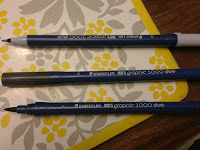 Eric: I draw with the most rudimentary materials. I'm the least professional when it comes to the inking and penciling tools that I use. I say, whatever gets the job done. My main inking tool is a brush marker that's made by Staedtler Mars called a 'Graphic Duo 3000' - which is a watercolor brush that has zero lightfast properties. Also, if there's any sort of moisture in the air, the ink will just infuriatingly smear at the least opportune time. On finer details, I ink with a really simple, disposable set of technical pens with widths ranging from 005 to 08.
Eric: I draw with the most rudimentary materials. I'm the least professional when it comes to the inking and penciling tools that I use. I say, whatever gets the job done. My main inking tool is a brush marker that's made by Staedtler Mars called a 'Graphic Duo 3000' - which is a watercolor brush that has zero lightfast properties. Also, if there's any sort of moisture in the air, the ink will just infuriatingly smear at the least opportune time. On finer details, I ink with a really simple, disposable set of technical pens with widths ranging from 005 to 08.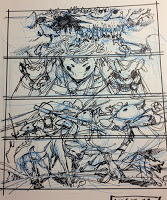 I used to do the painstaking process of drawing really tight thumbnails, using a photocopier to enlarge them on a bigger piece of paper, then using a light box to transfer the images onto bristol board in pencil before going to ink. But as I learned, a lot of the spontaneity of the page went away when I did that. So now, I just draw a small thumbnail, then using that rough drawing as a guideline, I redraw the page larger. My attitude is, 'The simpler, the better'.
I used to do the painstaking process of drawing really tight thumbnails, using a photocopier to enlarge them on a bigger piece of paper, then using a light box to transfer the images onto bristol board in pencil before going to ink. But as I learned, a lot of the spontaneity of the page went away when I did that. So now, I just draw a small thumbnail, then using that rough drawing as a guideline, I redraw the page larger. My attitude is, 'The simpler, the better'. David: Comic storytelling aside, you became a hero to me when you announced your new commission policies a few years ago, saying that after drawing countless Iron-Man, Bat-Man, Wonder Woman, and every other major character you wanted to only do original drawings in the spirit of certain characters. I know you’ve covered this before, but for the readers of my blog would you explain why you made that decision, how it’s been received, and after over a year of doing it how you feel about it now?
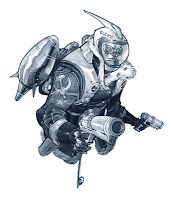 Eric: That's very kind of you to say. It's been a challenge to stay relevant to an audience who clamor for that sort of fan service, but I think that this new policy I've adopted speaks toward my over all mental and artistic longevity.
Eric: That's very kind of you to say. It's been a challenge to stay relevant to an audience who clamor for that sort of fan service, but I think that this new policy I've adopted speaks toward my over all mental and artistic longevity.The story goes that I was in Lucca, Italy drawing for a fans who've never seen me in person and who were very kind to drop by my booth to buy a copy of my art book called 'FOTO' published by Lateral Studio. It's typical in European conventions to draw free sketches with every purchase and considering that I was there under the good graces of my publisher, I was more than happy to oblige.
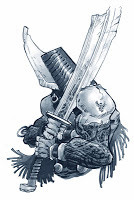 Whenever a fan would buy a book I caught myself asking them to choose a character for me to draw and when they did I would get to the task of drawing that character. Only this time, I'd recognized that I no longer had the same fervor that I used to have whenever someone asked me to draw for them. I guess you could say that I just wasn't into it, but I believe it was more than that. And until I found out what the reasoning was, I felt terrible about charging good money to people if I wasn't investing myself in each of the drawings. I didn't think it was fair and I didn't thing it was right - they came all this way to meet me, they had spent their hard-earned money in supporting my books and I couldn't even give them something (even if it was only for a brief moment) I was excited about? Like I said - that wasn't right.
Whenever a fan would buy a book I caught myself asking them to choose a character for me to draw and when they did I would get to the task of drawing that character. Only this time, I'd recognized that I no longer had the same fervor that I used to have whenever someone asked me to draw for them. I guess you could say that I just wasn't into it, but I believe it was more than that. And until I found out what the reasoning was, I felt terrible about charging good money to people if I wasn't investing myself in each of the drawings. I didn't think it was fair and I didn't thing it was right - they came all this way to meet me, they had spent their hard-earned money in supporting my books and I couldn't even give them something (even if it was only for a brief moment) I was excited about? Like I said - that wasn't right.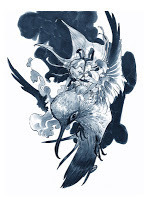
After that experience, I went home and did some hard personal evaluation. The simple version is that I had drawn SO MUCH fan art which I updated on my blog, that I had inadvertently drawn any and all characters who I'd wanted to draw already. I spent five or six years drawing for myself or at conventions for other people (all the versions of Character X, Y and Z) that all the while I had somehow run out of an artistic opinion about them. Does that make any sense at all? Put simply, I had drawn so much... I don't know, let's say... Captain America, that I had simply nothing else to say about the character now. And it stopped being fun.
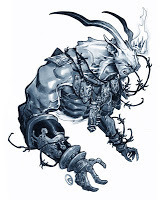 So instead, I would inform people who were interested in getting a commission from me that I have a policy called '"n the Spirit of...". Basically it meant that I would decline their request for drawing Captain America specifically, but I would be more than happy to draw my version of Captain America for them. Sometimes they'd decline for whatever reason - and I respected that. But more often than not, they'd see it as an exciting opportunity to get something new and original, and they'd be totally excited to be involved.
So instead, I would inform people who were interested in getting a commission from me that I have a policy called '"n the Spirit of...". Basically it meant that I would decline their request for drawing Captain America specifically, but I would be more than happy to draw my version of Captain America for them. Sometimes they'd decline for whatever reason - and I respected that. But more often than not, they'd see it as an exciting opportunity to get something new and original, and they'd be totally excited to be involved.It's been a year a few months since then and it's still been a pretty exciting endeavor for me. The point of the whole thing is that I wanted to make sure that each fan willing to pay me money for an original is getting all my time and effort. With this new policy I find myself vested, excited, and most of all, I've found that the fans of my work are VERY happy to walk away with something that's not the typical fare. People are really amazing when they're given an opportunity to be. That's what I love the most about my fans.
David: When you aren’t storyboarding or making comics, what do you like to do for fun?
 Eric: There's hardly any time for extracurricular activities these past few months. But any time I can get away, I love spending time with my fiancée Cassandra. She's an accidental comedian, so she knows how to crack me up without even trying. We do really super-simple activities like go to movies and different places throughout the city. I've been such a home body throughout my life that experiencing new things when we go exploring is really easy.
Eric: There's hardly any time for extracurricular activities these past few months. But any time I can get away, I love spending time with my fiancée Cassandra. She's an accidental comedian, so she knows how to crack me up without even trying. We do really super-simple activities like go to movies and different places throughout the city. I've been such a home body throughout my life that experiencing new things when we go exploring is really easy.We have dogs that we love taking for walks. The sort of adventures they get themselves into in a the span of 45 minutes is pretty entertaining. I know this sort of sounds mundane and boring, but I get a lot out of it because I spend a bit too many hours sitting behind the desk.
 Exercise is huge for me. I try to maintain a consistent work out regimen, but that can be challenging due to deadlines and daily things that get in the way. But I am convinced that health and longevity is an important investment you have to make in yourself so as best as I can, I try to eat well, work out 4-5 a week and get regular sleep.
Exercise is huge for me. I try to maintain a consistent work out regimen, but that can be challenging due to deadlines and daily things that get in the way. But I am convinced that health and longevity is an important investment you have to make in yourself so as best as I can, I try to eat well, work out 4-5 a week and get regular sleep.David: What projects are coming up next that folks should look out for?
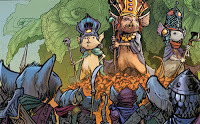 Eric: I'm on a huge sabbatical from doing anything that's going see publication or air any time soon. I'm just working on the next phase of my career and right now that involves the simple act of actually working and not talking about it. I'm not trying to be vague, but when the time comes, it'll be easier to talk about. I hope that makes sense? In the mean time, fans of your blog and your books should really keep an eye out for 'Legends of the Guard' - I would love to hear their thoughts and feedback about my contribution.
Eric: I'm on a huge sabbatical from doing anything that's going see publication or air any time soon. I'm just working on the next phase of my career and right now that involves the simple act of actually working and not talking about it. I'm not trying to be vague, but when the time comes, it'll be easier to talk about. I hope that makes sense? In the mean time, fans of your blog and your books should really keep an eye out for 'Legends of the Guard' - I would love to hear their thoughts and feedback about my contribution.David: I think that's pretty exciting, it means big things are in the works :) Thanks again Eric. Where should Legends of the Guard fans find out more about you and your work?
Eric: It's my pleasure, David! They can find me in the usual social media haunts. My blog is updated less and less frequently these days: kahnehteh.blogspot.com. I have joined the present and opened a Tumblr account: ericcanete.tumblr.com. And if you want to track me in my semi-daily shenanigans, I'm on Twitter more than I should be: @EricCanete. Thanks again for the interview and the opportunity.
Eric's Story The Mouse Generals will appear in Legends of the Guard Volume 2 # 3along with stories by C.P. Wilson III & Cory Godbey
Upcoming Appearances:Granite State Comicon: September 28-29New York Comic Con: October 10-13North Carolina Comic Con: November 9-10
Published on September 24, 2013 06:00
September 17, 2013
Spotlight on Legends of the Guard contributor Charles Paul Wilson III:
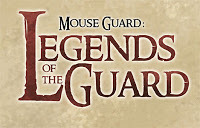
David Petersen: Charles, It was great to have you on board to tell a Legends of the Guard story. I’d like to start by talking about your own comic series (with collaborators Mike Raicht & Brian Smith) The Stuff of Legend. I consider it to be an all-ages series. How do you artistically handle telling a story that will be read by adults and children? Is it something you work at and think about or just a natural subconscious process?
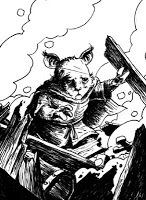 Charles Paul Wilson III: Something we encountered early on after our first book's release was while we felt it was all ages, it wasn't completely all ages. Especially after meeting a lot of readers at comic conventions who feel comfortable letting their eight-year-old read it but hold off on handing it to their younger ones. Paraphrasing Mike Raicht, I've started saying it's ages Empire Strikes Back and up. But I still try to be as accommodating as I can to the youngest reader we can get our book in front of without compromising what we've established in our first book or sacrificing areas of story we feel should go a bit dark.For those unfamiliar with The Stuff of Legend, it's about a boy who is kidnapped by The Boogeyman and dragged into another world populated by the boy's lost and forgotten toys. His current favorite toys mount a rescue mission to go get him and when they arrive in this other world they become realistic versions of themselves - the toy soldier becomes a real soldier, the teddy bear becomes a giant, ferocious grizzly and the jack-in-the-box becomes an acrobatic jester. And there are a lot of different characters they encounter and a variety of places they travel to in their efforts to get their boy back. I should also mention it takes place in 1944 (it's a bit of a period piece)!David: For your Legends of the Guard story, you wrote and drew the story. Did you find it hard to exercise the writing muscle, or was it a natural extension of creating a story through images?
Charles Paul Wilson III: Something we encountered early on after our first book's release was while we felt it was all ages, it wasn't completely all ages. Especially after meeting a lot of readers at comic conventions who feel comfortable letting their eight-year-old read it but hold off on handing it to their younger ones. Paraphrasing Mike Raicht, I've started saying it's ages Empire Strikes Back and up. But I still try to be as accommodating as I can to the youngest reader we can get our book in front of without compromising what we've established in our first book or sacrificing areas of story we feel should go a bit dark.For those unfamiliar with The Stuff of Legend, it's about a boy who is kidnapped by The Boogeyman and dragged into another world populated by the boy's lost and forgotten toys. His current favorite toys mount a rescue mission to go get him and when they arrive in this other world they become realistic versions of themselves - the toy soldier becomes a real soldier, the teddy bear becomes a giant, ferocious grizzly and the jack-in-the-box becomes an acrobatic jester. And there are a lot of different characters they encounter and a variety of places they travel to in their efforts to get their boy back. I should also mention it takes place in 1944 (it's a bit of a period piece)!David: For your Legends of the Guard story, you wrote and drew the story. Did you find it hard to exercise the writing muscle, or was it a natural extension of creating a story through images?
 Charles: Ha ha yeah, kinda. Planning a story for someone else with a limited page count, I think it was a tough first time. I've always liked writing stuff for myself, whether it's just words on paper or in the computer or I want to draw them out, I still do, but I felt a bit nervous, and excited, contributing both story and art. David: Did you start the story development with a script or an outline, or did you just start sketching story beats? I know we talked about story ideas, but I don't know your full process.Charles: Once you and I figured out what I was going to do I wrote down some captions that wound up in the middle of the story. They were the first things that came to mind and wound up staying through to the finish and then I worked through thumbnail drawings and wrote it out as I went along, if I remember it right. It kinda came together by itself in the end though. I do remember asking myself what I was focusing on concerning areas of the plot and why they were important, and then I made story around them. Like our main character's wooden sword, what it says about him that he made it and how he intends to use it and what his foes' weapons, what they are or how they were probably acquired and how they're intended for use, say about both his foes and him in contrast.
Charles: Ha ha yeah, kinda. Planning a story for someone else with a limited page count, I think it was a tough first time. I've always liked writing stuff for myself, whether it's just words on paper or in the computer or I want to draw them out, I still do, but I felt a bit nervous, and excited, contributing both story and art. David: Did you start the story development with a script or an outline, or did you just start sketching story beats? I know we talked about story ideas, but I don't know your full process.Charles: Once you and I figured out what I was going to do I wrote down some captions that wound up in the middle of the story. They were the first things that came to mind and wound up staying through to the finish and then I worked through thumbnail drawings and wrote it out as I went along, if I remember it right. It kinda came together by itself in the end though. I do remember asking myself what I was focusing on concerning areas of the plot and why they were important, and then I made story around them. Like our main character's wooden sword, what it says about him that he made it and how he intends to use it and what his foes' weapons, what they are or how they were probably acquired and how they're intended for use, say about both his foes and him in contrast.
 David: The text for your story is all told in rhyme. What led you to that choice of wordplay? Charles: I think it was originally supposed to spark some direction and help me get to where I was going. I looked at myself and tried to think of something creative and fun I could do with my story, something that would maybe contribute to the whole of the book. Maybe something that could sit alongside all of the other storytellers' stories without embarrassing me too much, maybe, but mostly it was a fun aspect of putting the story together.David:Your story “When Moles are Around” deals with an unlikely friendship between a mouse & mole that has both good and bad consequences. Where did the idea for this story come from?
David: The text for your story is all told in rhyme. What led you to that choice of wordplay? Charles: I think it was originally supposed to spark some direction and help me get to where I was going. I looked at myself and tried to think of something creative and fun I could do with my story, something that would maybe contribute to the whole of the book. Maybe something that could sit alongside all of the other storytellers' stories without embarrassing me too much, maybe, but mostly it was a fun aspect of putting the story together.David:Your story “When Moles are Around” deals with an unlikely friendship between a mouse & mole that has both good and bad consequences. Where did the idea for this story come from?
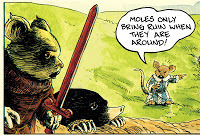 Charles: Initially I wanted to write a story with mice interacting with wolves. I went back and re-read all of the Mouse Guard books and found some references to wolves, but my ideas began to look like other mouse versus predator stories that were already told and I was also concerned my offering would fall more on the bland side of things. And it would have.So instead of a versus story I thought I'd make a buddy story and asked you what relationships would be like between mice and moles or rats. And you said something like mice probably wouldn't get along with moles well, that they'd dig up their housing foundations, and so I ran with that and worked it into and throughout the story. David: The baddies in your story are pretty gritty and nasty, which I love. Was there a backstory or reason you pushed them in that direction and wearing bones and shells and such?
Charles: Initially I wanted to write a story with mice interacting with wolves. I went back and re-read all of the Mouse Guard books and found some references to wolves, but my ideas began to look like other mouse versus predator stories that were already told and I was also concerned my offering would fall more on the bland side of things. And it would have.So instead of a versus story I thought I'd make a buddy story and asked you what relationships would be like between mice and moles or rats. And you said something like mice probably wouldn't get along with moles well, that they'd dig up their housing foundations, and so I ran with that and worked it into and throughout the story. David: The baddies in your story are pretty gritty and nasty, which I love. Was there a backstory or reason you pushed them in that direction and wearing bones and shells and such?
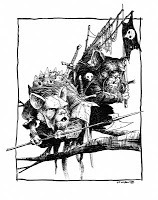 Charles: I think I remember imagining them as pirates, or plunderers, and they would wear outfits made up of leaves and sticks and whatever else was lying around. And that some of their outfits were made up of animals they've killed, but more telling would be what animals. One of them wears a small turtle shell, which would suggest this mouse killed a young, slow moving animal, and the leader has a bunch of baby bird skulls tied to his back. So essentially they're bullies who pick on weaker animals, or kill them and take what they want. Their insignia is a baby bird skull, probably due to some backstory with the leader. Maybe he couldn't kill a full grown bird so he went after its children, or maybe those mice developed a taste for bird flesh and somehow they thought the bird skull insignia would best represent what they are, or maybe it's a joke.
Charles: I think I remember imagining them as pirates, or plunderers, and they would wear outfits made up of leaves and sticks and whatever else was lying around. And that some of their outfits were made up of animals they've killed, but more telling would be what animals. One of them wears a small turtle shell, which would suggest this mouse killed a young, slow moving animal, and the leader has a bunch of baby bird skulls tied to his back. So essentially they're bullies who pick on weaker animals, or kill them and take what they want. Their insignia is a baby bird skull, probably due to some backstory with the leader. Maybe he couldn't kill a full grown bird so he went after its children, or maybe those mice developed a taste for bird flesh and somehow they thought the bird skull insignia would best represent what they are, or maybe it's a joke.
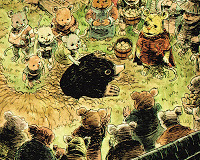 David: Is there a moral or take home lesson in your story?Charles: I think there are a few things that can be pulled from the story that would serve as a moral or lesson, none of them my intention really, but what I like about it is two friends creatively, purposefully and inadvertently, find ways to triumph over adversity on all sides and remain friends. David: On my blog, I talk a lot about process and materials, and my fans are always really interested to know about that stuff too. Walk us through the process from rough to watercolored page for this story. And tell us the materials used.
David: Is there a moral or take home lesson in your story?Charles: I think there are a few things that can be pulled from the story that would serve as a moral or lesson, none of them my intention really, but what I like about it is two friends creatively, purposefully and inadvertently, find ways to triumph over adversity on all sides and remain friends. David: On my blog, I talk a lot about process and materials, and my fans are always really interested to know about that stuff too. Walk us through the process from rough to watercolored page for this story. And tell us the materials used.
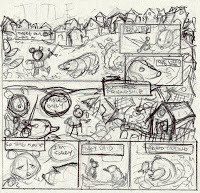 Charles: For this story, and I don't always work this way, but for these pages I started with small thumbnail sketches for each page. Sometimes I work bigger. I laid out the lettering as well as the illustration in the thumbs, but I planned on working with the word balloons and caption boxes more closely than I would if I were to hand it off to someone else so I made sure I knew how they would function with the art on the page before I started. Anyway, I usually do thumbnails sketches or roughs on typing paper.I then took the thumbs and, using a photocopy machine, blew them up until they were about 10"x10" each. I sometimes use a computer printer for this. It can be more precise and before I print I can use photoshop to move things around if I want. Panels, figures, whatever.I used 11"x14" Strathmore Bristol paper (the yellow pad), 100 lb. smooth as the final paper. There's thicker paper out there that buckles less with watercolor and washes but I guess I've gotten used to this.After ruling out the image area on the final paper (10"x10") I lightboxed the layouts up.
Charles: For this story, and I don't always work this way, but for these pages I started with small thumbnail sketches for each page. Sometimes I work bigger. I laid out the lettering as well as the illustration in the thumbs, but I planned on working with the word balloons and caption boxes more closely than I would if I were to hand it off to someone else so I made sure I knew how they would function with the art on the page before I started. Anyway, I usually do thumbnails sketches or roughs on typing paper.I then took the thumbs and, using a photocopy machine, blew them up until they were about 10"x10" each. I sometimes use a computer printer for this. It can be more precise and before I print I can use photoshop to move things around if I want. Panels, figures, whatever.I used 11"x14" Strathmore Bristol paper (the yellow pad), 100 lb. smooth as the final paper. There's thicker paper out there that buckles less with watercolor and washes but I guess I've gotten used to this.After ruling out the image area on the final paper (10"x10") I lightboxed the layouts up.
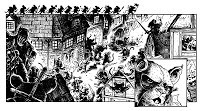 I've been favoring softer pencil lead so I probably used HB or 2B when I penciled the pages.For inking I used Micron pens. I traveled a lot last year and with Microns I could work over pages almost anywhere.Using the lightbox, I drew the word balloons and caption boxes on separate sheets of paper. I hadn't hand-lettered anything in a long while so it took a few tries until I got it how I liked it.I have an old Daler-Rowney watercolor set I drag with me everywhere too, and I used those for color.I scanned the art and letters into photoshop, made adjustments in color and lettering placements as well as some lettering corrections and sent the pages off!
I've been favoring softer pencil lead so I probably used HB or 2B when I penciled the pages.For inking I used Micron pens. I traveled a lot last year and with Microns I could work over pages almost anywhere.Using the lightbox, I drew the word balloons and caption boxes on separate sheets of paper. I hadn't hand-lettered anything in a long while so it took a few tries until I got it how I liked it.I have an old Daler-Rowney watercolor set I drag with me everywhere too, and I used those for color.I scanned the art and letters into photoshop, made adjustments in color and lettering placements as well as some lettering corrections and sent the pages off!
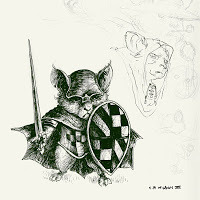 David: How do you work best? in silence, around others? with the right background sounds?Charles: Depending on what I'm doing sometimes I like it quiet. Especially during script-reading and thumbnailing pages or roughing out anything in general. Sometimes I like music during the thumbnail process, but even then that primarily consists of putting a single track on repeat for hours and hours on end.In all other stages, and again, depending on what I'm doing, I could also listen to tv shows and audiobooks, or more music and quiet. And sometimes I like to Skype with my friends while they draw. I also found this great Magic Window app for the iPad that plays ocean, lake and wind sounds with some moving scenery, and that's nice to have on while I draw.
David: How do you work best? in silence, around others? with the right background sounds?Charles: Depending on what I'm doing sometimes I like it quiet. Especially during script-reading and thumbnailing pages or roughing out anything in general. Sometimes I like music during the thumbnail process, but even then that primarily consists of putting a single track on repeat for hours and hours on end.In all other stages, and again, depending on what I'm doing, I could also listen to tv shows and audiobooks, or more music and quiet. And sometimes I like to Skype with my friends while they draw. I also found this great Magic Window app for the iPad that plays ocean, lake and wind sounds with some moving scenery, and that's nice to have on while I draw. David: What do you have coming up next in your list of projects we should look out for?
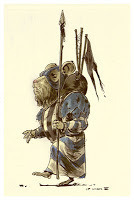 Charles: We're currently wrapping up The Stuff of Legend, Volume IV: The Toy Collector with two more volumes to go! And this summer I'll be working on a book called WRA1TH with Joe Hill (Locke and Key) that ties into his NOS4A2 novel that was just released in April. I also have a slew of variant covers coming out ranging from Wild Blue Yonder and X Files to Regular Show and possibly a web strip I've got in the works called BEWARE THE STARE!David: Wow! That's a lot going on! Charles, thanks for the interview, and for the story. Where can people find out more about you and your work?Charles: You can find me on twitter @cpwilsoniii or on facebook (Charles Paul Wilson III).Original art and commissions can be purchased/arranged through Bob at www.comicarthouse.com (email -bob@comicarthouse.com).And if you're on deviantart you can find me at www.cpwilsoniii.deviantart.com!Charles' story When Moles are Around will appear in Legends of the Guardvolume 2 #3 along with stories by Eric Canete & Cory Godbey
Charles: We're currently wrapping up The Stuff of Legend, Volume IV: The Toy Collector with two more volumes to go! And this summer I'll be working on a book called WRA1TH with Joe Hill (Locke and Key) that ties into his NOS4A2 novel that was just released in April. I also have a slew of variant covers coming out ranging from Wild Blue Yonder and X Files to Regular Show and possibly a web strip I've got in the works called BEWARE THE STARE!David: Wow! That's a lot going on! Charles, thanks for the interview, and for the story. Where can people find out more about you and your work?Charles: You can find me on twitter @cpwilsoniii or on facebook (Charles Paul Wilson III).Original art and commissions can be purchased/arranged through Bob at www.comicarthouse.com (email -bob@comicarthouse.com).And if you're on deviantart you can find me at www.cpwilsoniii.deviantart.com!Charles' story When Moles are Around will appear in Legends of the Guardvolume 2 #3 along with stories by Eric Canete & Cory GodbeyUpcoming Appearances:Granite State Comicon: September 28-29New York Comic Con: October 10-13North Carolina Comic Con: November 9-10
Published on September 17, 2013 06:00
September 10, 2013
Spotlight on Legends of the Guard contributor Cory Godbey:

David Petersen: Cory, I really appreciate you doing a story for Legends of the Guard and for doing this interview. Let’s start with your background in art. Are you one of those people that started drawing before they could walk? Did you have an artistic family member? Were you enrolled in art classes? Did you go on to college or art school for it?
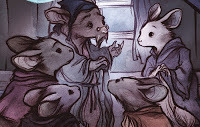 Cory Godbey: Hey, it's my pleasure! Yeah, my background's not all that interesting. It's true I was one of those kids. I just liked to draw. One story that I've told before is from Kindergarten when I was five. I remember we had to draw what we wanted to be when we grew up. I had no idea (since Super Mario was probably out) so I just drew a policeman. I gave him one of those old time-y cop hats, you know, with the badge on the front, and I vividly remember sitting there thinking, "Hey, that looks pretty good."
Cory Godbey: Hey, it's my pleasure! Yeah, my background's not all that interesting. It's true I was one of those kids. I just liked to draw. One story that I've told before is from Kindergarten when I was five. I remember we had to draw what we wanted to be when we grew up. I had no idea (since Super Mario was probably out) so I just drew a policeman. I gave him one of those old time-y cop hats, you know, with the badge on the front, and I vividly remember sitting there thinking, "Hey, that looks pretty good."I didn't go to art school, exactly, but I majored in art in college. I feel largely self taught; I saw the work I wanted to do and pursued that learning from everyone I could find. From my own friends to Peter de Sève and Carter Goodrich, to the Golden Age Illustrators, to Maurice Sendak, I couldn't get enough.
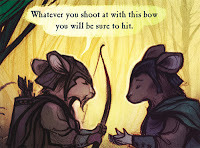 David: You were headed on a more illustration type trajectory and started dabbling in comics. Can you talk about the Flight anthologies and your involvement and stories? Were those your first comics?
David: You were headed on a more illustration type trajectory and started dabbling in comics. Can you talk about the Flight anthologies and your involvement and stories? Were those your first comics?Cory: Sure, I think that's what lends my comics work some of it's interest. Or maybe another way to put it is that's when people comment on my comics work that's what they notice. My background is illustration, especially fantasy illustration, and that's always been my passion. I love drawing and painting. I love creating a series of pieces that tell a story or give people an imaginative springboard to spark their own ideas. I'm drawn to that field because it marries together so many of the things that I prize: draftsmanship, creativity, imagination, storytelling, all that. And comics are great because naturally they do the same. I feel right at home. It can be tough for me sometimes to spread all the energy over the course of so many pages and panels (rather than pouring everything into single images) but I enjoy the challenge.
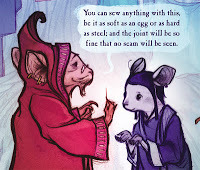
My involvement with Flight stemmed directly from my personal work and my love of picture books. I completed my first serious personal project, Ticket in 2008. I had met Kazu Kibuishi in 2005 at BookExpo in NYC (Flight was in it's second volume at the time). We talked a bit and he was just really kind, generous. He told me that when I felt I had something to show to feel free to send it his way. Once I had finished Ticket I thought, ok, I finally have something to show for myself. I wanted to send it to Kazu just to say thanks. We hadn't kept in touch since 2005 but I reached out in 2008 and told him that I was going to be at San Diego Comic-Con and I wanted to drop by and give him a copy. Next thing I knew Kazu was introducing me to the Flight crew saying I would join the sixth volume.
Beyond any comics I made in grade school, yeah, my work in Flight was my first comic. The sequential nature of Ticket (and picture books in general) was good preparation for it.

(Speaking of Ticket, on a whim I sent one to the Queen of England. She got the impression that I was a girl and addressed the response to a "Miss Cory Godbey.")
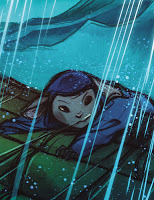 David: Well, "Miss Cory Godbey" (If that's what the queen calls you, why should I differ?)...When thinking about a short story for comics like your Flight stories or your Legends of the Guard story, how do you start? Do you start sketching, note taking? script writing?
David: Well, "Miss Cory Godbey" (If that's what the queen calls you, why should I differ?)...When thinking about a short story for comics like your Flight stories or your Legends of the Guard story, how do you start? Do you start sketching, note taking? script writing?Cory: I draw my stories out in words first. My notes sprawl across pages and pages. It's a mess. It's almost indecipherable. Then I do pretty rough thumbnails based on all the notes. I work to find the panels and pacing. From there it's usually a digital rough (meaning I scan the thumbnails and do a quick digital pass to strengthen them).
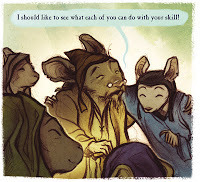 David: When you turned in your original draft/rough for your Legends story is was something like 18 pages, and you told me that you had over-shot on page count with your Flight stories too. Do you find this method of overtelling the rough helps you trim and cut the story into shape? or do you see it as a troubling process of making tough edits.
David: When you turned in your original draft/rough for your Legends story is was something like 18 pages, and you told me that you had over-shot on page count with your Flight stories too. Do you find this method of overtelling the rough helps you trim and cut the story into shape? or do you see it as a troubling process of making tough edits.Cory: Ha ha, yeah, my first Flight story, Walters, was exactly 60 pages. I was excited at the chance and wanted to show off a lot of huge illustrations, lots of single page pieces, several double page spreads. It just wasn't necessary. I edited that down to 40. It made the story tighter and it read much better. It was absolutely the right call on Kazu's part.
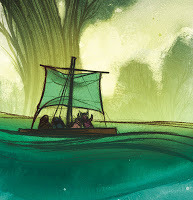 It's interesting (to me at least) because I think coming from illustration I want to tell the story in a single image and so to rethink that impulse and tell the story sequentially is a slight gear change. In writing, I've found that I just prefer to stretch out completely and write it (and thumbnail) exactly how I mean to then take stock and edit. It does help me decide what's most important and what could go. And to think, for my most recent Labyrinth comic (released on Free Comic Book Day) I was given four pages.
It's interesting (to me at least) because I think coming from illustration I want to tell the story in a single image and so to rethink that impulse and tell the story sequentially is a slight gear change. In writing, I've found that I just prefer to stretch out completely and write it (and thumbnail) exactly how I mean to then take stock and edit. It does help me decide what's most important and what could go. And to think, for my most recent Labyrinth comic (released on Free Comic Book Day) I was given four pages.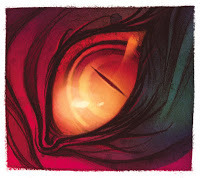 David: Your Legends story is a retelling of an existing folktale. Talk about that story, why you chose it and what Godbey-esque changes you made in the adaptation.
David: Your Legends story is a retelling of an existing folktale. Talk about that story, why you chose it and what Godbey-esque changes you made in the adaptation.Cory: Like most people, I think, I've always been drawn to fairy tales. Adapting a story like "The Four Clever Brothers" let me play with a collection of mice and explore their personalities through the skills they acquired. Illustrating that particular fairy tale has just always been something I wanted to do. Legends was the perfect excuse to do just that. Plus, dragon. Or beast. Or massive princess snatching creature, whatever you'd like to call it.
David: When it’s time to do the final art for the story, what is your process? What are the steps you take and with what materials?
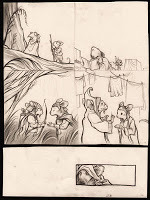 Cory: Once I finish the digital roughs and assemble the story into a PDF and it's approved I'll begin the actual illustrations. I struggle with forcing myself to draw in comic panels, everything collected and arranged on a single page. I dislike drawing small, I want room to stretch out in a drawing. Usually, I draw all the panels separately and assemble the page after the fact. I think with this story it was about half and half. Some pages I drew in panels, the other half I drew on their own and assembled, digitally.
Cory: Once I finish the digital roughs and assemble the story into a PDF and it's approved I'll begin the actual illustrations. I struggle with forcing myself to draw in comic panels, everything collected and arranged on a single page. I dislike drawing small, I want room to stretch out in a drawing. Usually, I draw all the panels separately and assemble the page after the fact. I think with this story it was about half and half. Some pages I drew in panels, the other half I drew on their own and assembled, digitally.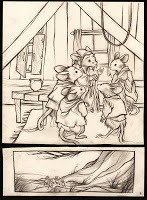 It's only a problem for the collector, at the point, I suppose. I like having original pages but when I feel like I'm compromising the quality of the drawing because I feel cramped in panels that when I work large. The paper I draw on is a type of printmaking paper. I've been hooked on it for the last ten years or more. Here's a sad story about that paper, though: it's just recently been discontinued and I'm going to have to migrate paper affinities elsewhere.
It's only a problem for the collector, at the point, I suppose. I like having original pages but when I feel like I'm compromising the quality of the drawing because I feel cramped in panels that when I work large. The paper I draw on is a type of printmaking paper. I've been hooked on it for the last ten years or more. Here's a sad story about that paper, though: it's just recently been discontinued and I'm going to have to migrate paper affinities elsewhere.David: Did the digital aspect grow out of wanting a quicker easier way to color than traditional materials? or do you find a creative benefit from your digital colors?
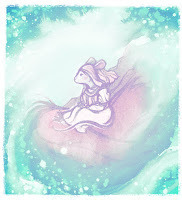 Cory: I like to tinker with colors. I almost never know where I'm heading when I start painting. I usually find my palette by playing (as they say, you don't wait for ideas, you get ideas by working). All of my drawing work is traditional, I really dislike drawing digitally. After the drawings are done though, it'll be a mix. Sometimes watercolor, sometimes watercolor and digital, sometimes just digital. Depends on the needs of the project and schedule.
Cory: I like to tinker with colors. I almost never know where I'm heading when I start painting. I usually find my palette by playing (as they say, you don't wait for ideas, you get ideas by working). All of my drawing work is traditional, I really dislike drawing digitally. After the drawings are done though, it'll be a mix. Sometimes watercolor, sometimes watercolor and digital, sometimes just digital. Depends on the needs of the project and schedule.David: Who would you cite as creative influences (feel free to venture outside the realm of illustrators or 2D artists into directors, sculptors, etc.)
 Cory: The progression of artists I've followed over the years follows along these lines: Peter de Sève, Carter Goodrich, H.B. Lewis, C.F. Payne.
Cory: The progression of artists I've followed over the years follows along these lines: Peter de Sève, Carter Goodrich, H.B. Lewis, C.F. Payne.At the same time I stumbled into picture books, the king of which I discovered to be Maurice Sendak. I also followed David Wiesner and Chris Van Allsburg. I love the works of Trina Schart Hyman.
Golden Age heroes include Arthur Rackham, Edmund Dulac, John Bauer. Studying those artists led me to follow Tony DiTerlizzi, Charles Vess, Brian Froud, J. B. Monge, Paul Bonner, and Petar Meseldžija.
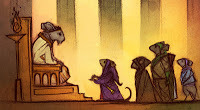
Other favorites are James Jean, Sam Weber, Sam Bosma, Kazu Kibuishi, and you know what, yourself too, Mr. Petersen.
David: Awww, thanks Cory. Every year you do a ‘personal project’ which is then published as a nice thick sketchbook with an overarching theme (past years include The Hidden People & Menagerie) Each one has the sense that what you show is a very rich portion of a much larger world. Do you have plans to ever delve deeper into those subjects, or do you feel that the books represent what you had to artistically say about them and leaving the audience wanting more is a good place to leave it?
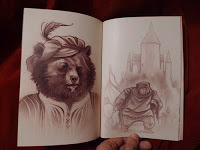 Cory: Ha ha! I know what answer you're looking for, David. Let's see if I can make this satisfying. Yes, every year I do one big personal project, one big new series of work. I've done this for the last six years. In my experience I haven't found anything that has benefited my career, portfolio, and reputation quite like creating yearly series of personal work. I work on it in and amongst my client work: plan a new series and work on it over several months. The next step is then to collect the work in a sketchbook, usually. And the fact is, it's been my personal work that's generated most of client work over the last few years. So in that regard, making the time for my personal work is just as important as my regular client work. I can trace a direct line from my very first personal project Ticket, 2008 to the Labyrinth project from Archaia and the Jim Henson Co.
Cory: Ha ha! I know what answer you're looking for, David. Let's see if I can make this satisfying. Yes, every year I do one big personal project, one big new series of work. I've done this for the last six years. In my experience I haven't found anything that has benefited my career, portfolio, and reputation quite like creating yearly series of personal work. I work on it in and amongst my client work: plan a new series and work on it over several months. The next step is then to collect the work in a sketchbook, usually. And the fact is, it's been my personal work that's generated most of client work over the last few years. So in that regard, making the time for my personal work is just as important as my regular client work. I can trace a direct line from my very first personal project Ticket, 2008 to the Labyrinth project from Archaia and the Jim Henson Co.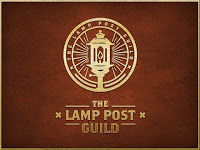 From concentrated personal development to a yearly portfolio refresh to new work (prints, sketchbooks, originals) to sell and promote your work, pushing yourself this way lends a lot of benefits. In fact, together with The Lamp Post Guild, we've put together an online art education course called The Art of Personal Work. It'll be available soon. http://www.lamppostguild.com
From concentrated personal development to a yearly portfolio refresh to new work (prints, sketchbooks, originals) to sell and promote your work, pushing yourself this way lends a lot of benefits. In fact, together with The Lamp Post Guild, we've put together an online art education course called The Art of Personal Work. It'll be available soon. http://www.lamppostguild.comOk, enough of that, here's the answer I think you're looking for: Part of the reason I got on this track was I just wasn't satisfied with my work. I had a bunch of stories I wanted to do but my drawing wasn't up to where my imagination was going. I set all of those aside for the time being and poured everything into bettering myself artistically. It's only been in the last year, really, that I've gotten back into any writing. It's something I love and something I'll always be pursuing but a quote by William-Adolphe Bouguereau expressing the sentiment perfectly, "And can there be such anguish compared to that felt by the artist who sees the realization of his dream compromised by weak execution?"

My most recent personal series is Lyrebird. It's available as a physical book on my etsy site
David: What hobbies do you have when not drawing and telling stories?
Cory: Other than that I ride my bike a lot, travel with my lovely wife Erin, and wrangle our four cats. And the usual I guess, books, movies, and some video games.
David: What projects are coming up next that folks should look out for?
Cory: The next one is great; I've partnered with a writer to illustrate a collection of short stories. If you at all enjoyed my book, The Hidden People, you're going to love this new project.
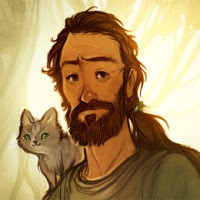 David: Cory, thanks again for doing the story and interview. Where can people find out more about you and your work?
David: Cory, thanks again for doing the story and interview. Where can people find out more about you and your work?Cory: Here's a few ways to keep updated:
Twitter: @corygodbey Which, as it turns out, is the best way to reach me.
My "Cory Godbey Illustration" Facebook page
News and new work on my main blog: http://lightnightrains.blogspot.com
Or these portfolio sites: http://tinyurl.com/corygodbey-contact-portfolio
Cory's Story The Thief, the Stargazer, the Hunter, and the Tailor will appear in Legends of the Guard volume 2 # 3along with stories by C.P. Wilson III & Eric Canete
Upcoming Appearances:Granite State Comicon: September 28-29New York Comic Con: October 10-13North Carolina Comic Con: November 9-10
Published on September 10, 2013 06:00
David Petersen's Blog
- David Petersen's profile
- 339 followers
David Petersen isn't a Goodreads Author
(yet),
but they
do have a blog,
so here are some recent posts imported from
their feed.



